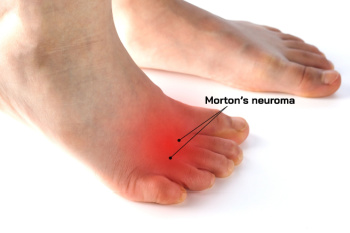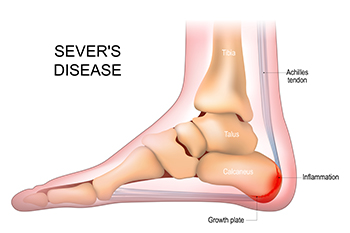Items filtered by date: September 2024
Facts About Morton’s Neuroma

Morton’s neuroma is a painful condition affecting the nerves in the ball of the foot, typically between the third and fourth toes. This condition occurs when the tissue around the nerve thickens due to irritation or pressure, often from wearing tight or high-heeled shoes. Symptoms of Morton's neuroma include sharp pain, burning, or a sensation like stepping on a small stone. Numbness or tingling in the toes can also be experienced. Risk factors include wearing narrow footwear, having foot conditions like flat feet or bunions, or engaging in high-impact sports. A podiatrist can provide custom orthotics, lifestyle modifications, or non-invasive therapies to alleviate discomfort and prevent long-term damage. If left untreated, Morton’s neuroma can lead to chronic pain and permanent nerve damage, like numbness in the toes. If you have pain in the ball of the foot that may be from Morton’s neuroma, it is suggested that you make an appointment with a podiatrist for an exam, diagnosis, and treatment options.
Morton’s neuroma is a very uncomfortable condition to live with. If you think you have Morton’s neuroma, contact Theresa Brown, DPM of Essie M.B. Smith Foot Clinic. Our doctor will attend to all of your foot care needs and answer any of your related questions.
Morton’s Neuroma
Morton's neuroma is a painful foot condition that commonly affects the areas between the second and third or third and fourth toe, although other areas of the foot are also susceptible. Morton’s neuroma is caused by an inflamed nerve in the foot that is being squeezed and aggravated by surrounding bones.
What Increases the Chances of Having Morton’s Neuroma?
- Ill-fitting high heels or shoes that add pressure to the toe or foot
- Jogging, running or any sport that involves constant impact to the foot
- Flat feet, bunions, and any other foot deformities
Morton’s neuroma is a very treatable condition. Orthotics and shoe inserts can often be used to alleviate the pain on the forefront of the feet. In more severe cases, corticosteroids can also be prescribed. In order to figure out the best treatment for your neuroma, it’s recommended to seek the care of a podiatrist who can diagnose your condition and provide different treatment options.
If you have any questions, please feel free to contact our office located in Montgomery, AL . We offer the newest diagnostic and treatment technologies for all your foot care needs.
Symptoms and Risk Factors of Sever’s Disease

Sever's disease, medically known as calcaneal apophysitis, is a condition that affects children and adolescents, particularly those who are active in sports. This condition involves inflammation of the growth plate in the heel, which is a cartilage area where the heel bone and tendons attach. Risk factors include activities that put repetitive stress on the heel, such as running or jumping, as well as being overweight. Symptoms often result in heel pain, which may worsen with physical activity. If your active child has heel pain, it is suggested that you visit a podiatrist who can recommend specific stretches for relief and guide you toward appropriate treatment methods.
Sever's disease often occurs in children and teens. If your child is experiencing foot or ankle pain, see Theresa Brown, DPM from Essie M.B. Smith Foot Clinic. Our doctor can treat your child’s foot and ankle needs.
Sever’s Disease
Sever’s disease is also known as calcaneal apophysitis, which is a medical condition that causes heel pain I none or both feet. The disease is known to affect children between the ages of 8 and 14.
Sever’s disease occurs when part of the child’s heel known as the growth plate (calcaneal epiphysis) is attached to the Achilles tendon. This area can suffer injury when the muscles and tendons of the growing foot do not keep pace with bone growth. Therefore, the constant pain which one experiences at the back of the heel will make the child unable to put any weight on the heel. The child is then forced to walk on their toes.
Symptoms
Acute pain – Pain associated with Sever’s disease is usually felt in the heel when the child engages in physical activity such as walking, jumping and or running.
Highly active – Children who are very active are among the most susceptible in experiencing Sever’s disease, because of the stress and tension placed on their feet.
If you have any questions, please feel free to contact our office located in Montgomery, AL . We offer the newest diagnostic and treatment technologies for all your foot and ankle injuries.
Symptoms of Arthritis in the Toes

Arthritis in the toes is caused by inflammation that affects the joints, particularly the big toe, though others may also be involved. Early symptoms often include pain, which can vary from a dull ache to a sharp, stabbing sensation when moving the toe. Arthritic toe pain can make even simple daily activities, like walking, challenging. Over time, stiffness can develop as the cartilage between the joints wears away, leading to reduced flexibility and mobility. Swelling, warmth, and redness around the affected toe joints are also common, making it difficult to wear shoes comfortably. You might hear clicking or popping sounds as the cartilage deteriorates, and in severe cases, the joint may become locked, further hindering movement. A podiatrist can diagnose this condition and recommend treatment to improve mobility. If you have inflammatory toe pain, it is suggested that you schedule an appointment with a podiatrist.
Arthritis can be a difficult condition to live with. If you are seeking treatment, contact Theresa Brown, DPM from Essie M.B. Smith Foot Clinic. Our doctor can provide the care you need to keep you pain-free and on your feet.
Arthritic Foot Care
Arthritis is a joint disorder that involves the inflammation of different joints in your body, such as those in your feet. Arthritis is often caused by a degenerative joint disease and causes mild to severe pain in all affected areas. In addition to this, swelling and stiffness in the affected joints can also be a common symptom of arthritis.
In many cases, wearing ill-fitting shoes can worsen the effects and pain of arthritis. Wearing shoes that have a lower heel and extra room can help your feet feel more comfortable. In cases of rheumatoid arthritis, the arch in your foot may become problematic. Buying shoes with proper arch support that contour to your feet can help immensely.
Alleviating Arthritic Pain
- Exercises that stretch the foot can prevent further pain and injury and increase mobility
- Most of the pain can be alleviated with anti-inflammatory drugs, heat, and topical medications
- Massages can help temporarily alleviate pain.
It is best to see your doctor for the treatment that is right for your needs and symptoms. Conditions vary, and a podiatrist can help you determine the right method of care for your feet.
If you have any questions, please feel free to contact our office located in Montgomery, AL . We offer the newest diagnostic tools and technology to treat your foot and ankle needs.
Wounds That Don't Heal Need to Be Checked
Foot Stress Fractures

Foot stress fractures are tiny cracks in the bones of the foot that result from repetitive stress or overuse, rather than a sudden injury. They most commonly occur in the weight-bearing bones, such as the metatarsals, navicular, calcaneus, or heel bone. These fractures are prevalent in athletes, particularly runners, dancers, and military recruits, due to the repetitive impact on the feet. Stress fractures develop when the bones are unable to withstand the repeated pressure and stress, especially if the activity level increases suddenly or the bones are weakened by conditions like osteoporosis. Symptoms include pain that worsens with activity, swelling, tenderness, and difficulty bearing weight on the affected foot. Diagnosis typically involves a physical examination, and imaging tests such as X-rays or an MRI scan may be required to confirm the fracture. Relief includes rest and avoiding weight-bearing activities. In some cases, a boot or crutches may be needed to allow the fracture to heal properly. If you have injured your foot, it is suggested that you visit a podiatrist for a proper diagnosis and treatment.
Activities where too much pressure is put on the feet can cause stress fractures. To learn more, contact Theresa Brown, DPM from Essie M.B. Smith Foot Clinic. Our doctor can provide the care you need to keep your pain free and on your feet.
Dealing with Stress Fractures of the Foot and Ankle
Stress fractures occur in the foot and ankle when muscles in these areas weaken from too much or too little use. The feet and ankles then lose support when walking or running from the impact of the ground. Since there is no protection, the bones receive the full impact of each step. Stress on the feet can cause cracks to form in the bones, thus creating stress fractures.
What Are Stress Fractures?
Stress fractures occur frequently in individuals whose daily activities cause great impact on the feet and ankles. Stress factors are most common among:
- Runners
- People affected with Osteoporosis
- Tennis or basketball players
- Gymnasts
- High impact workouts
Symptoms
Pain from the fractures occur in the area of the fractures and can be constant or intermittent. It will often cause sharp or dull pain with swelling and tenderness. Engaging in any kind of activity which involves high impact will aggravate pain.
If you have any questions please feel free to contact our office located in Montgomery, AL . We offer the newest diagnostic and treatment technologies for all your foot and ankle needs.




